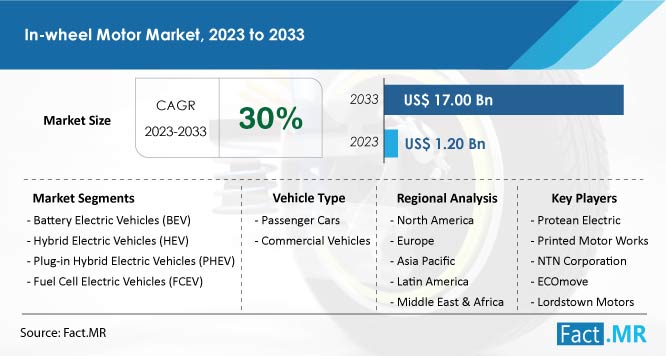As per Fact.MR, the global in-wheel motor market is valued at US$ 1.2 billion in 2023 and is predicted to reach US$ 17 billion by 2033-end. Global demand for in-wheel motors is forecasted to propel at a CAGR of 30% from 2023 to 2033.
Sales of axial motors are estimated to surge at a CAGR of 31% over the next ten years.
Axial motors that are small, light, and strong are gaining popularity. In electric cars, they can be employed as direct drives to boost output torque and effectiveness. In terms of power density and efficiency, axial motors perform better than radial motors. They are mostly employed in low-speed, high-torque circumstances.
In-wheel motors are widely used to enhance the performance of electric vehicles. These motors are installed directly on the wheels to power the wheel by sending torque to the respective tires. They make the vehicle lighter and more efficient. During the projection period, there will likely be a major increase in the demand for in-wheel motors.
The ability to put more components on the vehicle chassis is one of the main advantages of in-wheel motors. All forms of in-wheel motors have a substantial competitive advantage over more conventional electrical machines due to their flexibility to add batteries, range extenders, or simply retain baggage and passenger capacity during retrofits or new vehicle designs.
“Increasing Penetration of Electrical Vehicles Worldwide”
Since it brings people together and enables the exchange of goods and ideas, a healthy and efficient transportation sector is crucial for both economic and social development. There is a boom in interest in alternative road transportation propulsion technologies due to concerns about the limited supply of fossil-based fuels.
The use of in-wheel motors in electric cars reduces the weight of the vehicles by eliminating the area that the machines take up. Electric cars employ in-wheel motors, which have several benefits, including high power and torque densities, the capacity to run at high speeds with great efficiency, and at a comparatively lower cost.
Plug-in electric vehicles provide an enticing alternative to internal combustion engines due to regulatory restrictions to reduce city noise, CO2 emissions, and environmental impact. Worldwide demand for electric vehicles is expanding rapidly.
Competitive Landscape
Leading companies are focusing on product launches, quality control, product standards, supply chain management, and collaborations to increase their competitive share. They are concentrating on fully autonomous driving solutions while following safety regulations, which may open up lucrative opportunities for industry participants.
For instance,
- For the future generation of intelligent connected vehicles, Human Horizons, Protein Electric, and Wuxi Weifu e-Drive Technology formed a partnership to produce in-wheel hub motors.
- A new generation of automotive entertainment systems was created in collaboration with Google and Renault-Nissan-Mitsubishi. The sector is also witnessing a surge in the demand for comfort and safety features.

